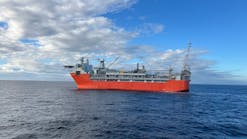Anne K. Rhodes
Refining/Petrochemical
Editor
The Oil & Gas Journal's survey of world ethylene capacity reveals a global total of more than 71 million metric tons/year (mt/y). This is an increase of more than 17 million mt/y, or 32%, since 1990 (OGJ, Sept. 10, 1990, p. 49).
The survey, which begins on p. 40, has been organized to provide additional data on feedstocks and plant ownership, where available. Where feedstock percentages were not provided by survey responders, an "X" indicates the feedstocks used, when known. Estimates of coproduct olefin production, such as propylene and butadiene, can be made based on feedstock composition.
Table 1 shows ethylene capacities by global region. North America is the largest producer, followed by Western Europe and the Asia/Pacific region, where growth is strongest.
Table 2 shows ethylene production totals by country. The top three producing countries are, in order, U.S., Japan, and Germany. Countries with 2 million mt/y or more capacity include Canada, France, The Netherlands, Saudi Arabia, Korea, Brazil, and China.
Ethylene
Global ethylene demand grew at about 5%/year in the 1980s. Growth rates slowed in 1991 and 1992, said Andrew B. Swanson, senior consultant for Chem Systems Inc., Tarrytown, N.Y., at the company's annual petrochemical seminar, Jan. 19-20, in Houston.
World ethylene demand was 62.9 million mt/y in 1992, according to Chem Systems. The company projects demand to grow at 4.5%/year until 2000, when it is expected to reach 88.7 million mt/y (Fig. 1).
In 1992, the U.S., Western Europe, and Japan accounted for 64% of ethylene demand, says Swanson. But this is forecast to fall to 56% in 2000. This decline is a consequence of higher demand growth in Asia, including China, and plans for substantial capacity expansions in the region, says Swanson.
The U.S. ethylene supply/demand picture, as seen by Dewitt & Co. Inc., Houston, is shown in Fig. 2. Capacity growth has been slower than DeWitt predicted in 1990. The total U.S. capacity that had been predicted for 1993 is now predicted for 1996. This is a difference of about 3.7 billion lb compared to earlier predictions, said Earl H. Armstrong Jr., group vice-president for DeWitt, at the company's annual petrochemical review, Mar. 22-24, in Houston. Fig. 2 shows that DeWitt expects capacity utilization to bottom at no less than 90% in 1995. This indicates that some improvement in operating results may occur this year, says Armstrong.
Western Europe continues to be long on ethylene and derivative capacity, according to DeWitt (Fig. 3). Declining demand growth for ethylene and derivates continues, but may be turning around, says Armstrong.
Because of new ethylene capacity at Finaneste N.V., BASF Corp., Enichem SpA, and BP plants, the need for spot purchases is declining. There has been some ethylene capacity rationalization in Western Europe, most notably by BP, says Armstrong, but polyethylene rationalization is needed, given the capacity surplus.
Europe has major growth opportunity in the expanding markets of Eastern Europe and the former Soviet Union, but the economies of those countries must be reestablished before that potential can be realized.
Chem Systems expects a rapid capacity buildup in Asia, Production will, however, continue to lag consumption, which is projected to grow at 9%/year, excluding Japan. Average operating rates will vary as new capacity comes on line, says Swanson.
The Middle East will continue its export focus for ethylene. Chem Systems projects capacity to increase from about 3.9 million mt/v in 1993 to about 6.5 million in 2000. Consumption rates will climb proportionately, producing a relatively steady operating rate of about 90% for the period.
For Latin America, Chem Systems forecasts 4.5%/year demand growth, with Mexico and Venezuela projected to be exporters.
Derivatives
Polymer growth also is expected to remain strong in the U.S., says Armstrong. And in Western Europe, the recycling of plastics is taking a smaller chunk of the market than was previously expected. This, says Armstrong, may provide a glimmer of optimism for the growth expectations of virgin resin.
Polyethylene
Chem Systems calculations show that global ethylene demand by end use was dominated by polyethylenes. The three types--low-density, high-density and linear low-density polyethylene (LDPE, HDPE, and LLDPE)--accounted for about 54% of total demand (Fig. 4).
DeWitt's Mark W. House, vice-president, polymers, says LDPE prices have deteriorated to historic lows in all three major markets (U.S., Western Europe, and Asia). LLDPE has not fared any better, but enjoys superior growth as film makers convert from LDPE because of lower costs and, in some cases, better properties.
In the U.S., LLDPE penetrated film markets by more than 50% last year, says House. That's twice the level in Europe or elsewhere. With such growth, supplies are often tighter than industry averages indicate.
The same price lows are true for HDPE, says House, as the down-cycle is being prolonged by continuing expansion. Producers who committed to cracker expansions 3 and 4 years ago are still catching up with derivative capacity (in other words, expanding in the face of oversupply).
Among the world's developed economies, only the U.S. is experiencing near-historic growth of polyethylene. Western Europe is impacted strongly by recession and recycling. And although there has been much talk of strategic alliances, the only real rationalization has arisen from the merger of portions of Neste Oy and Statoil to form Borealis.
Japan is experiencing especially hard times, says House, because of overdependence on exports, recession, and trade problems related to a strong Yen. In 1992, japan's polyethylene operating rates fell below 90% for the first time in 5 years.
Polypropylene
In the U.S., polypropylene demand has exceeded historic growth rates in the last 2 years, which has improved operating rates dramatically. With trade already deteriorated to levels expected later in the decade, prospects are excellent for U.S. producers.
The U.S. is already showing signs of balancing supply and demand, as operating rates are expected to exceed 90% in second quarter 1994. DeWitt expects trade deterioration by 1997, largely because of a tight domestic market.
Perhaps the biggest news in the U.S. is the merger of most of the polyolefins assets of Montedison SpA and Royal Dutch/Shell, called Shell/Montedison JV. The company is now the largest producer in both the U.S. and Western Europe.
Prices have been setting record lows since 1992 in the three major markets, says House. In spite of production curtailment, plant closures, and delayed start-ups, producers have been unable to achieve sustained price increases.
House expects North America to lead the world in timing for the turnaround. So expansion projects are coming off shelves for reconsideration. DeWitt expects Exxon Chemical, Fina Oil & Chemical Co., Phillips Petroleum Co., and Huntsman Chemical Corp. (incorporating Texaco Chemical Co.) to announce plans aimed at 1996.
Economic recovery is the key to a similar turnaround in Europe and Japan, says House. He expects recovery in Western Europe to lag the U.S. by about 1 year. Announced capacity increases will not, however, be sufficient to prevent tight supplies in 199698.
Recent changes in the Western European polypropylene situation include the Shell/Himont and Neste/Statoil ventures, and BASF's acquisition of ICI's plants.
Capacity in the region is 5.5 mt/y, about 35% of which now belongs to Shell/Montedison.
Japan, on the other hand, appears to be in lousy condition for recovery, according to House. He cites several reasons: too much capacity, too small a scale for many plants, too expensive a Yen for exports, too persistent a recession. DeWitt expects recovery there to lag until pulled on by markets in the rest of the world.
Asia is a net importer of polypropylene. In the next 5 years, says House, rapidly growing demand will offset new capacity to maintain that balance. The supply/demand balance is not expected to improve here until 1997, by which time the U.S. and European markets will have recovered from their current malaise.
Industry profitability can improve, says House, but another wave of expansion in developing countries is coming. There is plenty of chance, he adds, for players in the developed economies to overgrow again by 1998.
Polystyrene
Polystyrene prices have been severely depressed in Asia, compared to other markets. Growth of electronics and appliances has sparked dramatic growth, however, and styrene monomer supply is tightening, says House.
West European and U.S. markets have stabilized because of production curtailments in Europe and improved market conditions in the U.S. Demand growth in the U.S. has exceeded historic levels the last 2 years, and growth in Western Europe shows flattening as a result of the recession there.
Japanese operating rates fell below capacity for the first time in 5 years in 1992, says House. Japan was dealt a double blow as high-cost labor and currency effects depressed end-use industries for polystyrene.
PVC
Unlike other resins, polyvinyl chloride (PVC) prices have been increasing with good momentum since late 1992. Recession in Western Europe caused a "countercycle," according to House, which drove prices down to levels well below world values in mid-1993. The trend was reversed when European producers could export to Asia at better "netback" than domestic sales.
While strong demand in North America and Asia is the good news, the bad news is that chlorine prices have increased as caustic values have declined. In fact, chlorine price is near a record high. Most of the gain from price increases has been spent on chlorine, says House, to the dismay of all producers, integrated or not.
The growth pattern for PVC is similar to that of other resins-strong in the U.S., flat in Western Europe, and depressed in Japan. U.S. construction activity is booming because of low interest rates, economic growth, and pent-up housing demand, says House, all of which mean strong PVC demand in 1994.
As with other resins, Japanese PVC operating rates fell below capacity for the first time in 5 years.
Survey
The plant-by-plant listing of ethylene capacity from steam crackers begins on p. 40. Feedstock compositions are given where provided by the responder. Blanks in the table indicate lack of a response to the survey.
Those companies not responding to the survey are marked with an asterisk. For these plants, the Journal's best estimate of capacity is provided, based on news releases, data from previous surveys, and other sources.
The article following the survey delves into the nuances of ethylene markets in three areas on which Petrochemical producers around the world are keeping an eye: the U.S., Asia, and Latin America.
Copyright 1994 Oil & Gas Journal. All Rights Reserved.
For historical ethylene data, visit past OGJ Ethylene Report surveys.


